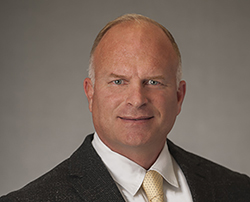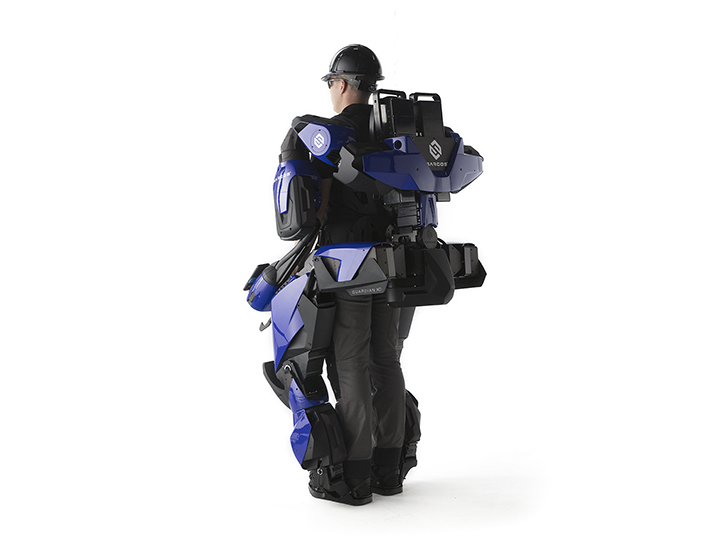
Exoskeletons Power Industry 4.0
Q. You’ve been in an exoskeleton. What was that like? And what did you learn from your company’s exoskeleton debut at the Consumer Electronics Show earlier this year?
A. I started with Sarcos at the very beginning of August 2019. I had my first experience stepping into a fully functional, full-body, independently powered exoskeleton during my third day on the job. It was a prototype that preceded the one we debuted at the Consumer Electronics Show (CES) in January. Then, late last year, I was able to get in the one we have now, the Guardian XO Alpha prototype.
It was amazing and exciting, as I’ve been watching this technology evolve for years. Before last August, I was only able to get into pieces and parts of prototype exoskeleton wearable robotics, but to get into a functional, full-body, load-bearing system, well, that’s different.
Think about being in a full-body exoskeleton and lifting something that normally would be a two-person lift, and to do it with one arm and have it feel like you’re lifting a single-serving (12 oz.) bottle of water. That’s what I was doing at CES, in that controlled environment, on that tight stage, and not applying any effort because the exoskeleton was doing the work. You could see people’s faces light up when they tried a separate single-arm demonstration as well. We recently began controlled user experiences in the Alpha unit — and faces continue to light up.
RELATED: Connected Exotechnology
Q. Before Sarcos, you were involved with the TALOS (Tactical Assault Light Operator Suit) program for the U.S. Special Operations Command (SOCOM). What lessons were learned from that program?
A. I grew up on the operational side of the military. My first experience with acquisitions, technology, and logistics was as the director of the TALOS project. I learned a lot about exoskeletons. I also learned a lot about the different kinds of technology that comprise the myriad forms of wearable robotics and exoskeletons, both passive and active. It was a great experience.
TALOS was the implementation of a big idea to do a lot of different things. It was an audacious, rapid prototyping effort to fuse various advanced technologies into a functional capability designed to dramatically increase a Special Operator’s capabilities. The Joint Acquisition Task Force TALOS was about more than simply striving to design and develop a game changer. The effort was about changing the acquisitions culture. It was about going after technology through unconventional, nontraditional methods; it was about reaching out to small companies at the front of their field of technology, leveraging their innovation and employing them to help influence cultural change at SOCOM.
We worked to achieve a technological and cultural change for SOCOM and hoped to have an instrumental change by advancing various technology areas, namely exoskeletons. We picked one of the greatest challenges: to put an elite athlete inside 200 to 300 pounds of equipment and enable them to move with finesse, grace, agility, and speed, maneuvering like they would without wearing all that equipment.
That’s why I go back to this big idea: To achieve disruptive technology innovation, you have to challenge current technology assumptions and pursue a vision through unconventional and nontraditional means without fear of failure. I learned a lot about research and development through the TALOS experience, where I had virtually no experience before.

Exoskeletons like the one pictured will enhance human abilities and revolutionize industry.
Q. The fields of robotics and exoskeletons are intertwined. What exoskeleton application area do you see growing the most in the next several years?
A. With every form and prototype of exoskeletons, we’ll learn more about the many opportunities for the integration and application of an exoskeleton in a workplace. The markets where we see the most immediate need for full-body exoskeleton technology include the automotive, aviation, industrial manufacturing, oil and gas, power, construction, logistics, and defense industries. Defense has several of these industries wrapped into it. For all of these, a full-body exoskeleton provides enhanced performance, risk reduction, and safety.
Q. The field of robotics is one of the key elements of Industry 4.0 and the Internet of Things. How do you see this field shaping the future of industry and manufacturing?
A. I think robotics will shape industry and manufacturing by attacking the labor shortage and on-the-job injuries. The U.S. may be short 2.4 million workers in the manufacturing sector by 2028, and that shortage may have an impact of up to $2.5 trillion on the U.S. economy. In addition, reducing risk to workers is something that industry struggles with. U.S. employers and employees spend in excess of $100 billion annually on back pain-related workplace injuries. People want to work, and they want relevant, challenging technology and training that leads to new opportunities in a reduced-risk work environment.
We’ll see these benefits with exoskeletons. Full-body exoskeletons will revolutionize the workforce of the future by producing robots that augment human performance by combining human intelligence, instinct, and judgment with the strength, endurance, and precision of machines to deliver enhanced safety and productivity for the myriad environments where automation isn’t feasible. They will augment human productivity while keeping humans safe and out of harm’s way, in addition to making manufacturing and other jobs more accessible to those who otherwise wouldn’t be able to perform them.
Beyond enabling superhuman strength for extended periods of time, one of the most notable aspects of wearable robotics is their ability to level the playing field in terms of physical capacity, which helps to foster workplace diversity. Roles that previously required certain physical abilities can now be performed by anyone, thanks to the performance capabilities of wearable robotics.
We can improve the worker’s environment and increase efficiency and effectiveness, keeping workers employed full time and longer in what they want to do. And it will be a workforce capability multiplier. I think this really is going to be a game changer.
As the technology evolves, you’ll see increased mobility and agility, and a corresponding decrease in exoskeleton size, weight, and power consumption. There are many opportunities for the workforce and industry to consider as we envision a progressive evolution of full-body exoskeleton technology, which will result in a high-performing, safe, balanced, and efficient workforce.
Q. What are the main goals you would like to see the new ASTM International Exo Technology Center of Excellence achieve? And how will exoskeleton standards help in the marketplace?
A. I think that the center’s desire to influence the vision and direction of the exoskeleton technology industry will compel collaboration among global leaders in the sector’s organizations, industry, and academia. These leaders will consider the full-body exoskeleton technology applications that will help transform the workplace, and I think it will inspire people to embrace technology opportunities.
If it hasn’t already, ASTM’s Exo Technology Center of Excellence (ET CoE) could benefit from input from an organization like the Exoskeleton Technical Advisory Group (X-TAG) that Sarcos formed in 2018. The X-TAG is comprised of executives from leading companies across a variety of industries, including industrial manufacturing, oil and gas, utilities, logistics, construction, automotive, aviation, and aerospace. The X-TAG was formed to collaborate on the design and development of the Guardian XO and to ensure the commercial XO product offering would meet the needs of customers across a broad range of industries.
READ MORE: The Future of Exoskeleton Standards
X-TAG input would help inform terminology and the standards, and key performance and safety requirements necessary to bring this technology to their industries. And they can help us understand what the consumer wants and needs, and any concerns, which will help us meet those needs in a more efficient, effective manner. My initial observations are that ASTM and the ET CoE are, in fact, a broad collective of stakeholders who seek to achieve what I described previously.
What’s really critical here is how ASTM International helps maintain and establish a fundamental common understanding for all stakeholders through the validation of standards and definitions. ASTM should be the go-to place for industry and academia.
ASTM already has the investment in standards overall and has had a positive impact by ensuring that people have a common point of departure for new technology, considerations for application and integration, and properly characterizing performance.
Going back at least to 2016 for me, ASTM has been part of the dialogue to establish standards and definitions as exoskeleton technology progressively began to emerge in the marketplace. People have been encouraged to be a part of that process, and many companies have contributed.
Q. Any final thoughts?
I’m thrilled to be a part of this transformative technology and excited that I’m able to continue my participation with it beyond my service in the military as an employee of Sarcos Robotics and as a member of the advisory board. It is an honor to be asked to participate on the ET CoE advisory board with folks who are some of the most well-respected leaders across industry, academia, and defense.
My personal experience with the Sarcos Guardian XO tells me that exoskeleton technology will, with absolute certainty, make a difference throughout many industries. We will continue to mature full-body exoskeleton technology that will usher in a safer and more productive work environment for many. There’s an amazing opportunity for us all to really make a difference by deploying full-body exoskeletons throughout industry and defense. I’m certain that it’s going to change the global workplace.
James (Jim) Miller, vice president of defense solutions at Sarcos Robotics, is a member of the ASTM International Exo Technology Center of Excellence advisory board. A retired U.S. Army Special Forces Colonel, Miller was previously and most recently the commander of the Joint Acquisition Task Force Tactical Assault Light Operator Suit at the U.S. Special Operations Command.
 SN Home
SN Home Archive
Archive Advertisers
Advertisers Masthead
Masthead RateCard
RateCard Subscribe
Subscribe Email Editor
Email Editor